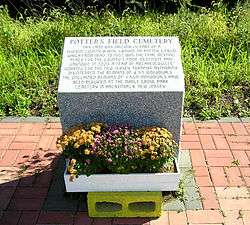Hudson County Burial Grounds
The Hudson County Burial Grounds are also known as the Secaucus Potter's Field and Snake Hill Cemetery and it is located in Secaucus, New Jersey.

The cemetery was cleared of bodies to make room for the Secaucus Transfer Station and Exit 15X of the New Jersey Turnpike between 1992-2003.[1][2][3] More than 4,000 bodies were disinterred. A few were identified and reburied by their families, but the rest were reinterred in a Hackensack cemetery.[4] (The bodies were to be interred at Hoboken Cemetery, North Bergen, but when pits were dug for the bodies, human remains were found, in what was sold as virgin cemetery space.[5][6])
It is estimated that there are another 5,000 or so graves that have not been found, probably lying outside the Secaucus Junction projects construction areas. Some may lie underneath footings and embankments of the New Jersey Turnpike.[4]
The bodies were reburied at the Maple Grove Park Cemetery in Hackensack, New Jersey. The last body was removed from the cemetery on October 31, 2003. The remains of 4,572 were transferred. The Register of Burials listed interments between December 31, 1880, and April 12, 1962, but those within the removal area were from between 1920 and 1962. The cemetery served the insane asylum and the poor house that later became the Meadowview Psychiatric Hospital.
Snake Hill
The Snake Hill region of Secaucus, New Jersey, was the location of the Old Bergen Poor Farm in the late 18th century. In 1840 the southern part of Bergen became Hudson County, which later purchased the land and placed their Insane Asylum and Alms House there.[7]
Archaeology
The Berger Group which performed the removals[8] wrote:
A total of 113,532 artifacts or non-skeletal objects were recovered of which over 50 percent were coffin nails. Other personal effects or "grave goods" included dentures, glass eyes, coins, clay smoking pipes, embalming bottles, whiskey/wine bottles, combs, over 4,500 buttons, over 500 ceramic fragments, clothing remnants, shoes, hats, jewelry, military medals, religious items, and medical devices or prosthetics. ... Using historic maps, original hand-written burial ledgers, osteological examination, background research, and artifact analysis, Berger's team was able to determine possible identities for approximately 900 of the disinterred remains. Of particular note, positive identifications were established for two interments who have living linear descendants. The remains of a woman who died in 1928 and a man who was buried in 1949 were returned to their respective families for private ceremonies and reburial - ending the search for their long-lost grandparents.[9]
References
- https://www.nytimes.com/2001/08/29/nyregion/potter-s-field-to-be-moved-for-turnpike-railroad-interchange.html
- Fallon, Scott (2003-11-30). "55 years later, reburial heals indignity. Family bids farewell to remains from potter's field.". Bergen Record. Archived from the original on 2016-01-14. Retrieved Dec 6, 2015 – via HighBeam Research.
When plans for the interchange were finalized two years ago, a team of 60 archeologists began unearthing grave after grave in what turnpike officials believe is the largest single exhumation in the nation's history ... [In a[ corner of the Hackensack cemetery, the remains of 4,570 other bodies have already been buried. The Turnpike Authority plans to pay for a large memorial to honor them in the spring.
- "A startling find at cemetery halts reburial". Bergen County, NJ: The Record. Archived from the original on 2016-01-14. Retrieved 2015-12-06 – via HighBeam Research.
The remains of thousands of people placed in a potter's field near the New Jersey Turnpike were supposed to get a proper burial this summer in a nearby cemetery.
But no longer. The reason: Hundreds of random pieces of bones and skulls have now been found in the exact spot where the remains were going. - "Snake Hill's secrets: 10 years ago, thousands of bodies were pulled from the Meadowlands". NJ.com. Retrieved 2015-12-06.
- "New burial spot needed for remains". Bergen Record. Retrieved 2007-08-21.
Exasperated turnpike officials say the Hoboken Cemetery in North Bergen violated its contract when it promised there weren't any prior burials in the 2,430-foot section reserved for the potter's field bodies. The cemetery says it has no record of any bodies and the remains could have been fragments excavated from other areas on its grounds. Nevertheless, it has agreed to return the agency's $150,000 by Friday - the cost for reinterring the bodies.
- "Families Think Potter's Field Holds Clues To Long Lost Kin". Bergen Record. Archived from the original on 2011-05-17. Retrieved 2008-04-05.
But to one Morris County man, a potter's field in Secaucus is more than an obstacle in the state's plan to build a sprawling $225 million turnpike interchange.
- "Background History and Review of Previously Conducted Studies" (PDF). Portal Bridge Capacity Enhancement Project DEIS. 2008. Archived from the original (PDF) on 2011-07-15. Retrieved 2011-03-20.
- Cho, Aileen (November 29, 2004). "Busy New Jersey Span Gets New Bearings, and Shorter Too". Engineering News-Record. 253 (21): 19–20. ISSN 0891-9526. Retrieved May 4, 2013.
- "The Secaucus Potter's Field Cemetery". Archived from the original on 2007-08-23. Retrieved 2007-08-26.
The Potter's Field Cemetery is one of three cemeteries documented in Secaucus near Laurel Hill, but it will be the only one impacted by the Secaucus Interchange Project. These three cemeteries were used to bury deceased indigents from Hudson County's former institutional complex at Snake Hill (now called Laurel Hill). ... According to historic documents, the Snake Hill region of Secaucus was occupied by the Old Bergen County Poor Farm in the late 1700s. In 1845, Old Bergen County split into Passaic and Bergen counties, and Hudson County purchased the poor farm to locate a variety of county facilities. In 1855, Hudson County began building several institutions here, and between 1855 and 1962, the facility included insane asylums, jails, almshouses, orphanages, hospitals, the county agricultural farm and piggery, and three cemeteries. The Potter's Field Cemetery, one of the three original cemeteries associated with the Hudson County facility, appears to have been established in the early twentieth century. In 1962, the cemetery ceased operations.